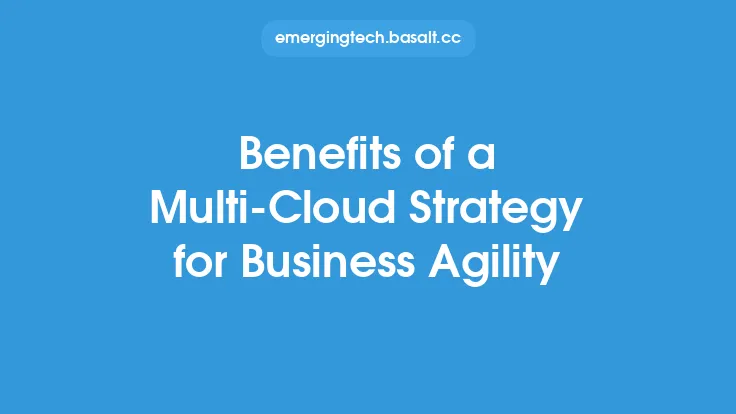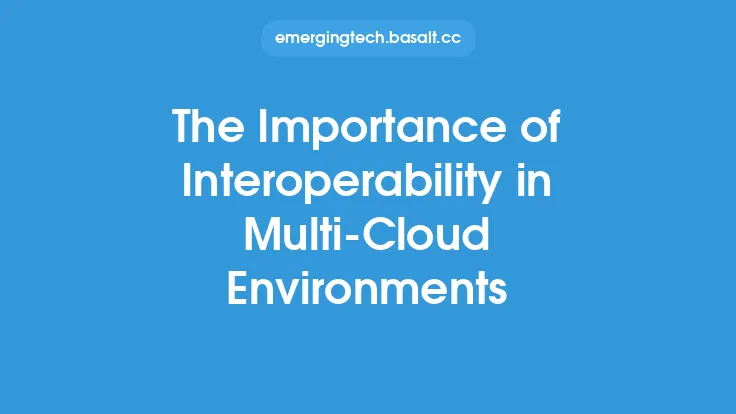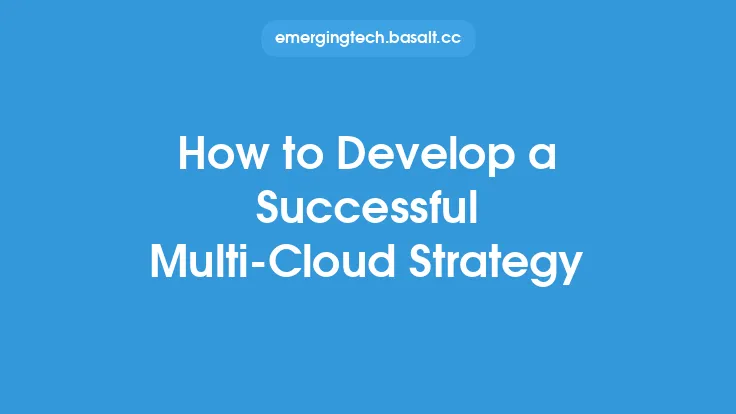In today's cloud computing landscape, organizations are increasingly adopting a multi-cloud approach to avoid vendor lock-in and maximize flexibility. Vendor lock-in occurs when a company becomes so deeply invested in a particular vendor's products or services that it becomes difficult or expensive to switch to a different vendor. This can limit an organization's ability to adapt to changing business needs, take advantage of new technologies, and negotiate favorable pricing.
Introduction to Vendor Lock-in
Vendor lock-in can take many forms, including proprietary software, hardware, or services that are not compatible with other vendors' offerings. In the context of cloud computing, vendor lock-in can occur when an organization uses a cloud provider's proprietary services, such as Amazon Web Services' (AWS) Lambda or Microsoft Azure's Cosmos DB. While these services may offer significant benefits, they can also make it difficult for an organization to move its applications or data to a different cloud provider.
The Risks of Vendor Lock-in
The risks of vendor lock-in are numerous and can have significant consequences for an organization. For example, if a cloud provider increases its prices or changes its terms of service, an organization that is locked in may have limited options for responding. Similarly, if a cloud provider experiences an outage or security breach, an organization that is locked in may be unable to quickly move its applications or data to a different provider. Additionally, vendor lock-in can limit an organization's ability to take advantage of new technologies or innovations, as it may be difficult or expensive to integrate these technologies with the organization's existing infrastructure.
Benefits of a Multi-Cloud Approach
A multi-cloud approach can help organizations avoid vendor lock-in by allowing them to use multiple cloud providers and avoid dependence on any one provider. This approach can offer several benefits, including increased flexibility, improved scalability, and enhanced negotiating power. With a multi-cloud approach, an organization can choose the best cloud provider for each application or workload, based on factors such as cost, performance, and security. This can help the organization optimize its cloud spending and improve its overall return on investment (ROI).
Key Considerations for a Multi-Cloud Approach
To implement a successful multi-cloud approach, organizations should consider several key factors. First, they should assess their current cloud usage and identify areas where they can benefit from a multi-cloud approach. This may involve evaluating their applications and workloads, as well as their cloud providers and contracts. Next, they should develop a cloud strategy that outlines their goals and objectives for using multiple cloud providers. This strategy should include provisions for managing multiple cloud providers, ensuring interoperability between clouds, and maintaining security and compliance.
Technical Considerations for Multi-Cloud
From a technical perspective, implementing a multi-cloud approach can be complex and require significant expertise. Organizations should consider several key technical factors, including cloud interoperability, data portability, and security. Cloud interoperability refers to the ability of different cloud providers to work together seamlessly, allowing organizations to move applications and data between clouds without interruption. Data portability refers to the ability of organizations to move their data between clouds, without being locked into a particular provider's storage or database services. Security is also a critical consideration, as organizations must ensure that their applications and data are protected across multiple clouds.
Cloud Management Platforms
To manage multiple cloud providers and ensure interoperability, organizations can use cloud management platforms (CMPs). CMPs are software solutions that provide a single interface for managing multiple cloud providers, allowing organizations to provision, monitor, and optimize their cloud resources across different providers. CMPs can also provide features such as cost management, security, and compliance, helping organizations to optimize their cloud spending and reduce risk.
Avoiding Vendor Lock-in with Open Standards
Another way to avoid vendor lock-in is to use open standards and APIs. Open standards, such as those developed by the Open Cloud Computing Interface (OCCI) and the Cloud Security Alliance (CSA), provide a common framework for cloud providers to implement, allowing organizations to move their applications and data between clouds without interruption. APIs, such as those provided by the AWS and Azure, allow organizations to access cloud services programmatically, making it easier to integrate cloud services with their existing infrastructure.
Best Practices for Avoiding Vendor Lock-in
To avoid vendor lock-in, organizations should follow several best practices. First, they should use open standards and APIs whenever possible, to ensure interoperability between clouds. Next, they should implement a cloud-agnostic architecture, using cloud-agnostic services and tools to avoid dependence on any one cloud provider. They should also develop a cloud strategy that outlines their goals and objectives for using multiple cloud providers, and includes provisions for managing multiple cloud providers and ensuring security and compliance.
Conclusion
In conclusion, avoiding vendor lock-in is a critical consideration for organizations adopting a multi-cloud approach. By using multiple cloud providers, implementing open standards and APIs, and following best practices, organizations can avoid dependence on any one provider and maintain flexibility and negotiating power. With the right strategy and technical expertise, organizations can optimize their cloud spending, improve their ROI, and achieve their business objectives in the cloud.





